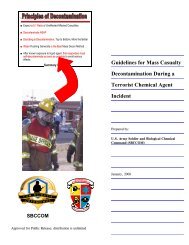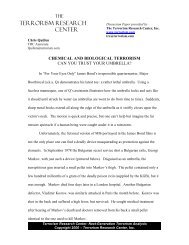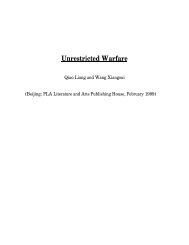Combating Proliferation of Weapons of Mass Destruction
Combating Proliferation of Weapons of Mass Destruction
Combating Proliferation of Weapons of Mass Destruction
You also want an ePaper? Increase the reach of your titles
YUMPU automatically turns print PDFs into web optimized ePapers that Google loves.
The <strong>of</strong>fice <strong>of</strong> the Assistant Secretary <strong>of</strong> Defense for Strategy and Threat Reduction isresponsible for national security strategy, including reducing and countering nuclear,biological, chemical, and missile threats to the United States and its forces and allies; armscontrol negotiations, implementation, and verification policy; denuclearization, threatreduction, and nuclear safety, security, and dismantlement in the former Soviet Union;counter-proliferation; policy and strategy for U.S. nuclear weapons and selected advancedconventional weapons; technology transfer; and relations with Russia, Ukraine, and otherNew Independent States.The Assistant Secretary <strong>of</strong> Defense for Special Operations and Humanitarian Assistance(continued as the Assistant Secretary <strong>of</strong> Defense for Special Operations and Low-IntensityConflict) is responsible for the overall supervision <strong>of</strong> special operations and low intensityconflict activities as well as peacekeeping and humanitarian assistance affairs.Acquisition and Technology: The Defense Reform Initiative called for the elimination <strong>of</strong>the Assistant to the Secretary <strong>of</strong> Defense for Nuclear, Chemical & Biological Defense andthe creation <strong>of</strong> a new Defense Threat Reduction and Treaty Compliance Agency under theDirector <strong>of</strong> Defense Research & Engineering. However, the 1999 Defense AppropriationAuthorization required a modification to this plan, as Congress effectively blocked theelimination <strong>of</strong> the Assistant to the Secretary <strong>of</strong> Defense for Nuclear, Chemical & BiologicalDefense (ATSD(NCB)). As implemented, the organizations for combating weapons <strong>of</strong>mass destruction within the <strong>of</strong>fice <strong>of</strong> the Under Secretary <strong>of</strong> Defense for Acquisition andTechnology are shown below.The Director <strong>of</strong> Defense Research and Engineering (DDR&E) exercises oversight andoverall coordination and integration <strong>of</strong> all Department <strong>of</strong> Defense science and technologyresearch and development. The DDR&E oversees the preparation <strong>of</strong> three key documentsdetailing these efforts including the Joint Warfighting Science and Technology Plan; theDefense Technology Area Plan, and the Basic Research Plan. (These documents arebelow.)There are two organizations with combating-proliferation responsibilities under theDirector <strong>of</strong> Defense Research and Engineering.• The Deputy Assistant to the Secretary <strong>of</strong> Defense for Counter-proliferation& Chemical and Biological Defense has oversight and overall coordinationand integration <strong>of</strong> all Department <strong>of</strong> Defense chemical and biologicaldefense research, development, and acquisition efforts. Additionally, this<strong>of</strong>fice provides the guidance for planning, programming, budgeting, andexecuting <strong>of</strong> the chemical and biological defense program.• The Defense Advanced Research Projects Agency is charged with seekingbreakthrough concepts and technologies. The Defense Sciences Officewithin the Defense Advanced Research Projects Agency manages itsbiological warfare defense program, which is intended to support the45







